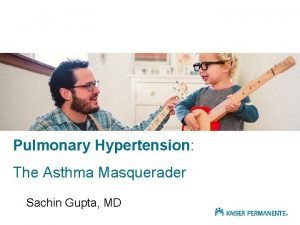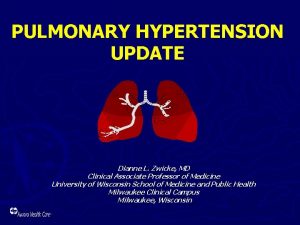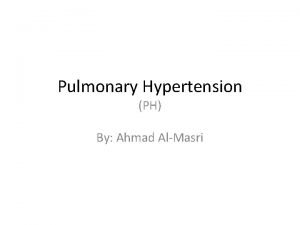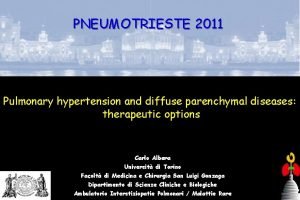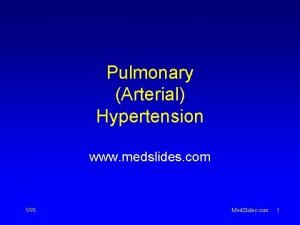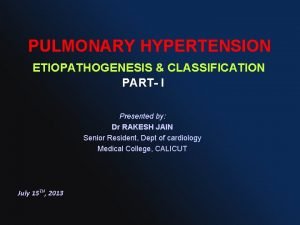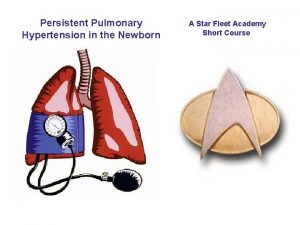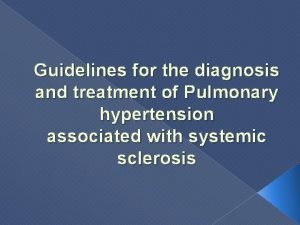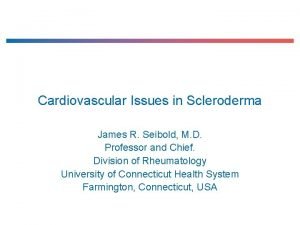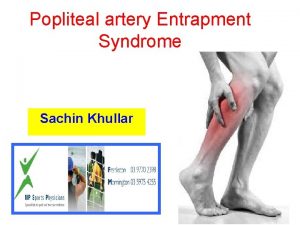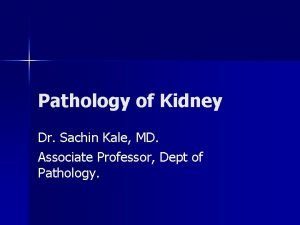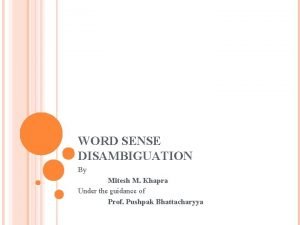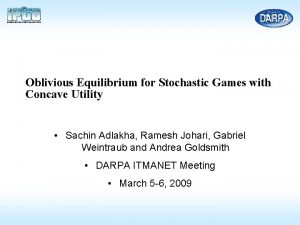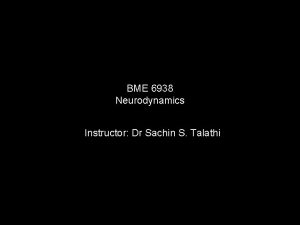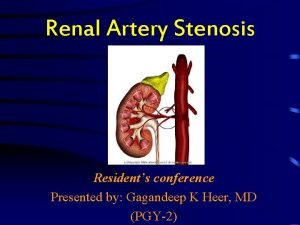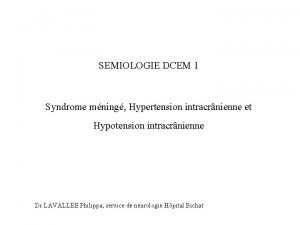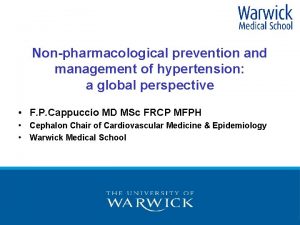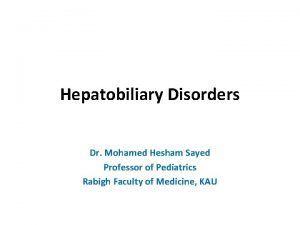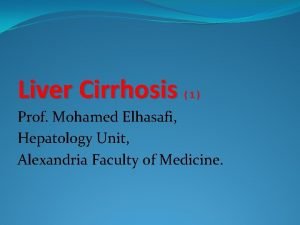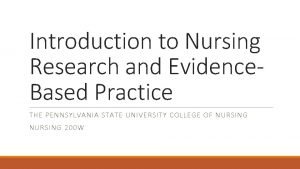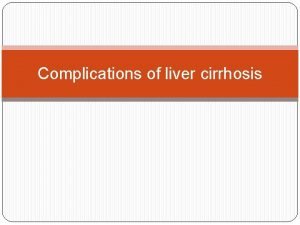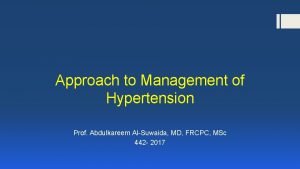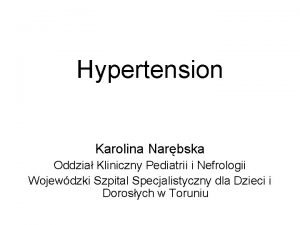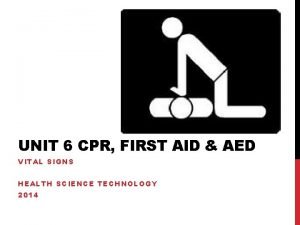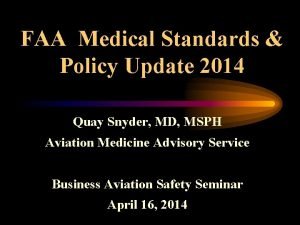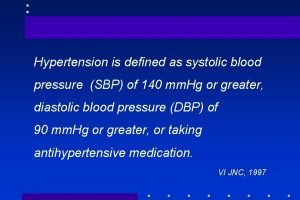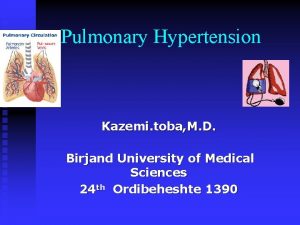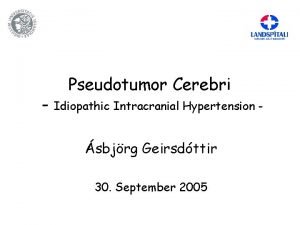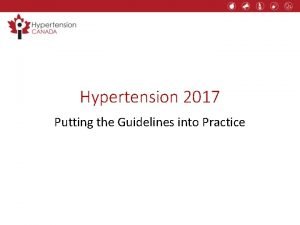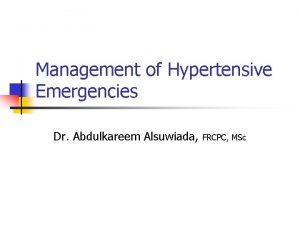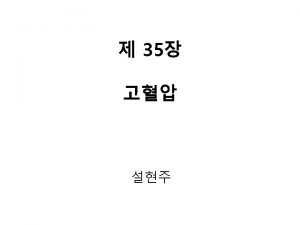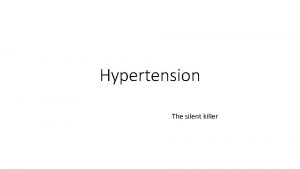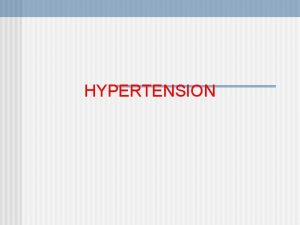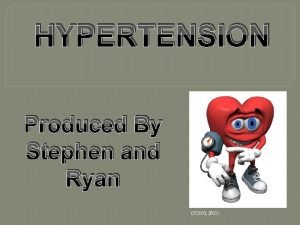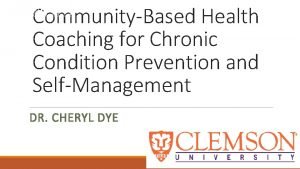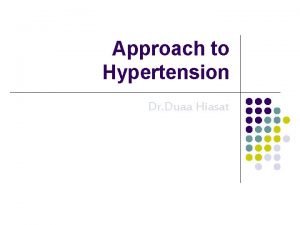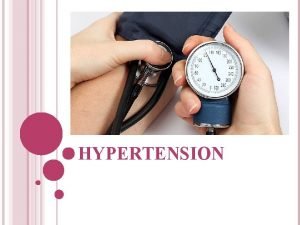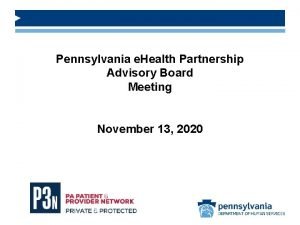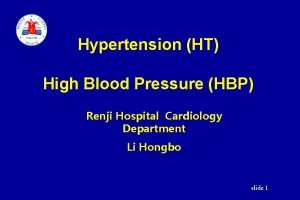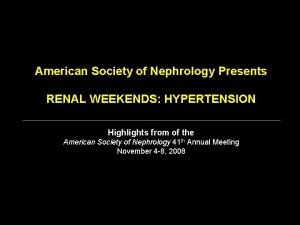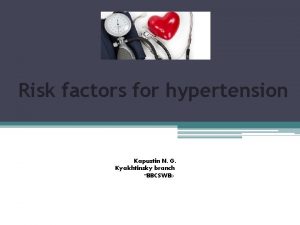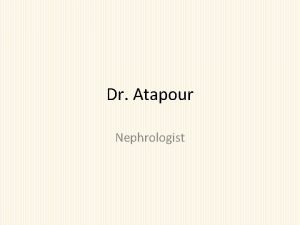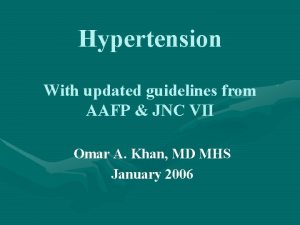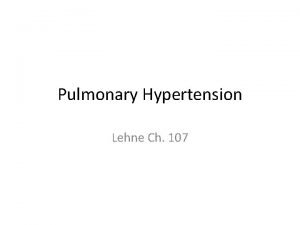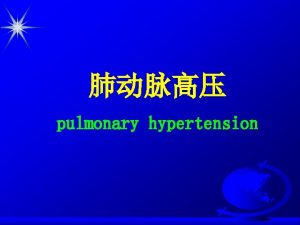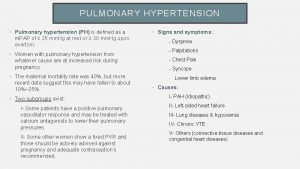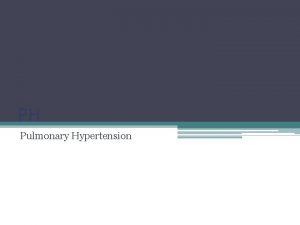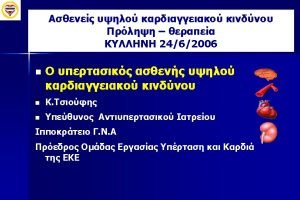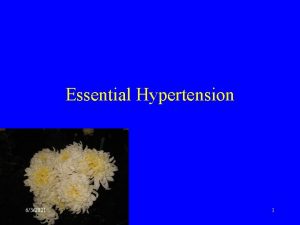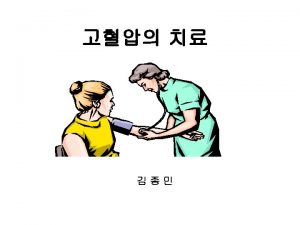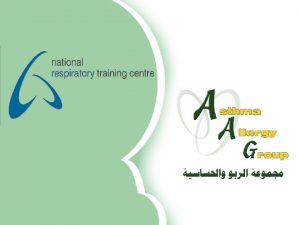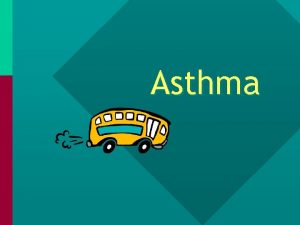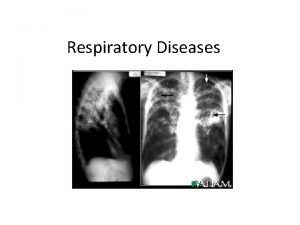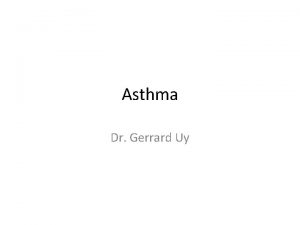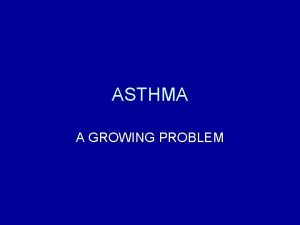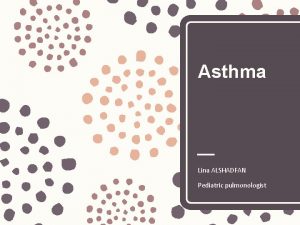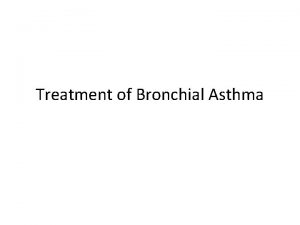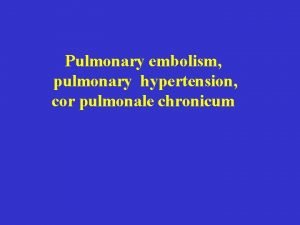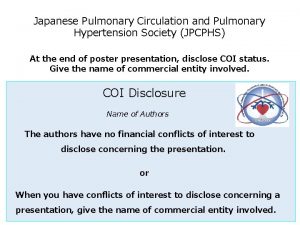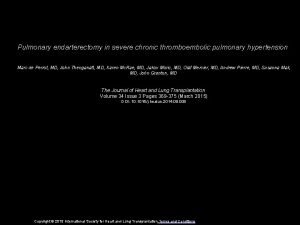Pulmonary Hypertension The Asthma Masquerader Sachin Gupta MD
































































- Slides: 64

Pulmonary Hypertension: The Asthma Masquerader Sachin Gupta, MD

Live Audience Polling: Poll Everywhere App Ø Please download from the Apple App. Store Ø Free, fast install, anonymous polling Ø Username: KPSF


About the Presenter • No financial disclosures or conflicts of interest

Outline Background Diagnosis Management Questions

Abbreviations o PH – Pulmonary Hypertension o PVH – Pulmonary Venous o Hypertension PAH – Pulmonary Arterial Hypertension o PVR – Pulmonary Vascular Resistance o CHD – Congenital Heart Disease o ILD – Interstitial Lung o IPAH – Idiopathic PAH Disease o CTEPH – Chronic Thromboembolic o Po. PH – Portopulmonary Pulmonary Hypertension o HFp. EF – Heart Failure with preserved EF o WHO FC – World Health o HFr. EF – Heart Failure with Organization Functional reduced EF Class

Case Vignette HOPI 34 y/o W with no significant PMHx presents with a chest tightness and dyspnea on exertion for 10 months. Referred from Primary care for refractory symptoms. Chest tightness noted with heavy exertion, at times associated with lightheadedness.

Case continued The patient denies wheezing. No skin rashes. Denies allergic rhinitis type symptoms. She frequently travels to Lake Tahoe and feels her symptoms are worse, particularly on exertion such as hiking. Given a trial of Albuterol and QVAR by her PCP, with a spacer. Initial improvement,

Case continued Peak flow measurements in primary care clinic around 350. Patient does not have a Peak flow meter at home. Extensive history in relation to triggers not helpful.

Case continued PMHx: Asthma PSHx: None Allergies: NKDA Family History: Mother with SLE, Father with CAD Social Hx: No tobacco, drug abuse. Occasional et. OH use. Lives by herself in San Leandro, works in retail

Exam: BP 126/68, HR 72, T 36. 7, RR 18, Peak flow 340, FENO 17 Height 5’ 2”, 61 kg General: NAD, full sentences Lungs: CTAB CV: RRR, S 1 S 2, no m/r/g Ext: no c/c/e Skin: tightening of skin http: //sclerodermainfo. org/Images/Telangiectasia-1. jpg

Labs/imaging: CBC – no peripheral eos Chem 7 – normal Basic spirometry – normal, no BD response EKG (3 months prior at an ER visit): RVH, rightward axis By Stillwaterising - Own work, CC 0, https: //commons. wikimedia. org/w/index. php? curid=9686540




Survival estimates of patients in REVEAL using Kaplan–Meier estimates stratified by newly versus previously diagnosed patients and survival estimated by a delayed entry model accounting for truncation. M. D. Mc. Goon, and D. P. Miller Eur Respir Rev 2012; 21: 8 -18 © 2012 by European Respiratory Society

What is Pulmonary Hypertension? A progressive condition caused by disease at the level of the pulmonary arteries.



Pulmonary Hypertension Physiology • Complex, multi-factorial condition • Endothelial dysfunction occurs early in disease pathogenesis and leads to: § endothelial and smooth muscle proliferation § remodelling of the vessel wall § impaired production of vasodilators (NO, prostacyclin) § overexpression of vasoconstrictors (endothelin 1)

Where is the Lesion? VC R A R V PA PC PV L A L V Ao ALK-1, activin receptor-like kinase 1; Ao, aorta; BMPR 2, bone morphogenetic receptor type 2; HHT, hereditary hemorrhagic telangiectasia; HIV, human immunodeficiency virus; LA, left atrium; LV, left ventricle; PA, pulmonary artery; PC, pulmonary capillary bed; PV, pulmonary vein; RA, right atrium; RV, right ventricle; VC, vena cava. Graphic adapted from http: //cme. medscape. com/viewarticle/530730.

Epidemiology PAH is uncommon § estimated prevalence of 15– 50 cases per million Idiopathic PAH § annual incidence of 1– 2 cases per million people in the US and Europe § 2 -4 times as common in women as men Prevalence is higher in at risk groups: § § Systemic sclerosis (~7– 12%) HIV infection (0. 5%) Sickle cell disease (2– 3. 75%) Schistosomiasis (4. 6%)

Epidemiology of PAH Prevalence of PAH in associated conditions: Distribution of PAH in French Registry Appetite suppressant § CTDa: 8%-12% § CHD: 15%-30% >1 Risk factor IPAH HIV § Po. PH: 2%-6% § HIV: 0. 5% Po. PH CHD a Systemic sclerosis. CHD, congenital heart disease; CTD, connective tissue disease; FPAH, familial pulmonary arterial hypertension; HIV, human immunodeficiency virus; IPAH, idiopathic pulmonary arterial hypertension; Po. PH, portopulmonary hypertension. . FPAH CTD

Screening high risk populations Results of a disease registry in France § Without screening, the majority of patients were diagnosed in WHO FC III or FC IV and only 24% of patients were in WHO FC II at diagnosis § With screening, PAH was detected at earlier stage 1. Humbert M et al. Am J Respir Crit Care Med 2006; 2. Hachulla E et al. Arthritis Rheum 2005

Outline Background Diagnosis Management Questions


Poll – sx of pah 1. 2. 3. 4. 5. 6. 7. Cough, wheeze DOE, CP Fatigue, pre-syncope Edema, palpitations 1&3 2, 3, 4 All of the above

Symptoms DOE - 2 Years - 70% Fatigue- 90% Peripheral Edema – 10% CP - RV ischemia - 30% Raynaud’s phenomen on- 10% Early Satiety – 50% Syncope / near syncope – 30% Ascites- 20% Hoarseness- 10%

Evaluation • History & Physical • Labs- CBC, BMP, LFT, TSH, ANA, CCP, CRP, ESR, HIV, Anticardiolipin Ab, BNP, Tn. I • EKG, CXR • PFT – Spiro, Lung volumes, DLCO • Echocardiogram


Poll Which of the following are exposures that place patients at risk of developing PAH? 1) SSRI 2) Bactrim 3) Methamphetamines 4) Phen-fen 5) PPI 6) 4&5 7) 2&3 8) 3&4

Approach to Diagnosis Clinical suspicion of PH § Symptoms, known risk factors Exclusion of Group 2 (left heart disease) and Group 3 (lung disease) PH § ECG, chest radiograph, echocardiography, PFTs PH specialist evaluation • V/Q scan, Polysomnogram, 6 MWT, cardiac MRI, Right heart catheterization Galiè N et al. Eur Heart J 2009


Poll – TTE relevant findings Name 4 markers of PAH on an echocardiogram: a) LA dilatation, LV wall thickening, PASP 45, Moderate mitral regurgitation b) RA dilatation, RV dysfunction, PASP 40, Mild tricuspid regurgitation c) LA dilatation, RA dilatation, PASP 60, Severe aortic regurgitation d) RA dilatation, LV dilatation, PASP 35, Mild aortic stenosis

Outline Background Diagnosis Management Questions

Management

Functional class Functional Class I II IV Symptomatic profile Patients with pulmonary hypertension but without resulting limitation of physical activity. Ordinary physical activity does not cause dyspnoea or fatigue, chest pain, or near syncope Patients with pulmonary hypertension resulting in slight limitation of physical activity. They are comfortable at rest. Ordinary physical activity causes undue dyspnoea or fatigue, chest pain, or near syncope Patients with pulmonary hypertension resulting in marked limitation of physical activity. They are comfortable at rest. Less than ordinary activity causes undue dyspnoea or fatigue, chest pain, or near syncope. Patients with pulmonary hypertension with inability to carry out any physical activity without symptoms. These patients manifest signs of right heart failure. Dyspnoea and/or fatigue may even be present at rest. Discomfort is increased by any physical activity

1 Humbert M et al. Circulation 2010

6 minute walk test (6 MWT) Measure of patients’ functional limitations Simple, inexpensive, convenient

Right heart cath

RHC Interpretation Defined by: Mean PA pressure > 25 mm. Hg PCWP < 15 mm. Hg PVR > 2. 5 / 3. 0 m. PAP by Severity: 26 -35 Mild 36 -45 Moderate 46 -55 Severe > 55 Systemic

Hemodynamic Progression of PAH Symptomatic/ Decompensating Pre-symptomatic/ Compensated Declining/ Decompensated CO Symptom Threshold PAP PVR RAP ms S to p ym Right Heart Dysfunction Time CO, cardiac output; PAP, pulmonary arterial pressure; PVR, pulmonary vascular resistance; RAP, right atrial pressure.

General measures • General measures § Limit effects of external circumstances § avoid pregnancy § prevention and prompt treatment of chest infections § awareness of the potential effects of altitude • Conventional or supportive therapy § Provide symptomatic benefit § supplemental oxygen § oral anticoagulants § diuretics

Advanced (PAH-specific) therapy • Endothelin receptor antagonists (ERAs) • Synthetic prostacyclins and prostacyclin analogues • Phosphodiesterase-5 (PDE-5) inhibitors • Guanylate cyclase stimulator

SILDENAFIL (Revatio) / TADALAFIL (Adcirca) • PDE – 5 Inhibitor • Found abundantly in pulmonary vasculature • Inhibits proliferation • Potent pulmonary vasodilation • Increased epistaxis and GI bleed • Can’t prescribe nitrates

BOSENTAN (Tracleer) / AMBRISENTAN (Letairis) / MACITENTAN (Opsumit) • ET – 1 antagonist • Binds ETA – ETB receptors in endothelium and vascular smooth muscle • Oral agents • Caution in pregnancy • Caution hepatotoxicity

RIOCIGUAT (Adempas) • Oral agent • Approved for CTEPH and IPAH • Contraindicated in pregnancy • Cannot be combined with PDE 5 inh • Variable plasma concentrations

ILOPROST (Ventavis) • Inhaled prostacyclin derivative • 6 -9 treatments/day • 10 -15 minutes/treatment • Demonstrated benefit in FC 4 patients

EPOPROSTENOL (Flolan, Veletri) • Prostacyclin, IV • 75% sustained ¯ in PVR • 10% are non responders • Improved FC and mortality • Requires continuous infusion

TREPROSTINIL (Remodulin) • Prostacyclin analogue • SQ or IV infusion • Modified insulin pump – SQ

SELEXIPAG (Uptravi) • Oral prostacyclin receptor agonist • BID dosing • Indicated for FC 2 and 3 patients • Reduced disease progression and hospitalization • Similar side effects as prostacyclins

Has Survival Meaningfully Improved With Modern Therapies? IPAH, HPAH, and anorexigen-associated PAH 100 After 2000 (current therapies) 1992 -1999 (only IV PGI 2) Before 1992 (no specific Tx) Survival (%) 75 n=269 NS n=260 50 25 n=118 0 P<0. 05, log-rank test 0 12 24 36 48 60 Months HPAH, hereditary pulmonary arterial hypertension; IPAH, idiopathic pulmonary arterial hypertension; IV, intravenous; NS, not significant; PGI 2, prostacyclin; Tx, treatment.

PAH Treatment – Bottom Line • Currently no cure for PAH • PAH therapies can markedly improve a patient’s symptoms and slow the rate of clinical deterioration Management is complex, involving use of a range of treatment options: § § § general measures conventional or supportive therapy advanced therapy (PAH-specific therapy) surgical intervention lung transplantation



Poll PH is managed by: a) Cardiologists b) Pulmonologists c) Neither d) Both

Who you gonna call? Cardiology Anne Goh, MD Cardiology Dana Mc. Glothlin, MD Pulmonary Sachin Gupta, MD


Questions?

Thank you for the invitation!!!


Appendix

Screening for PAH in SSc: suggested screening protocol for the detection of PAH in SSc patients Figure adapted from: The three-year incidence of pulmonary arterial hypertension associated with systemic sclerosis in a multicentre nationwide longitudinal study in France 1. Hachulla E, de Groote P, Gressin V, et al. Copyright © 2009, John Wiley and Sons, Inc. Reproduced with permission of John Wiley and Sons, Inc. 1. Hachulla E et al. Arthritis Rheum 2009

What is the role of exercise? Ø Exercise improves exercise capacity and QOL q Important adjunct to medical therapy q Avoids deconditioning from being sedentary q PH isn’t a contraindication to judicious exercise Ø Encourage patients to remain active within symptom limits q Mild breathlessness is acceptable q Avoid severe breathlessness, exertional dizziness, near syncope, or chest pain q Isometric exercises discouraged due to exertional syncope
 Chd pulmonary hypertension
Chd pulmonary hypertension Dianne zwicke
Dianne zwicke Nervous mechanism for regulation of blood pressure
Nervous mechanism for regulation of blood pressure Pulmonary hypertension definition
Pulmonary hypertension definition Pulmonary hypertension
Pulmonary hypertension Pah vs pulmonary hypertension
Pah vs pulmonary hypertension Bmpr gene
Bmpr gene Stages of pulmonary hypertension
Stages of pulmonary hypertension Rvsp calculation
Rvsp calculation Mitral stenosis pulmonary hypertension
Mitral stenosis pulmonary hypertension Pulmonary hypertension
Pulmonary hypertension Pulmonary hypertension differential diagnosis
Pulmonary hypertension differential diagnosis Pathophysiology definition
Pathophysiology definition Dr. sachin khullar
Dr. sachin khullar Sachin bhatkar
Sachin bhatkar Hemoptasis
Hemoptasis Sachin tendulkar
Sachin tendulkar Sachin thorbole
Sachin thorbole Sachin adlakha
Sachin adlakha Sachin kheterpal
Sachin kheterpal Sachin kale eye specialist
Sachin kale eye specialist Sachin talathi
Sachin talathi Sachin amrute
Sachin amrute Dr mahesh marda
Dr mahesh marda Virtualization wireless infrastructure
Virtualization wireless infrastructure Dash diet
Dash diet Gagandeep singh bedi
Gagandeep singh bedi Talipes equinovarus in varicose veins
Talipes equinovarus in varicose veins Definition of hypertension
Definition of hypertension Oedeme papillaire stade
Oedeme papillaire stade Hypertension
Hypertension Ascites veins
Ascites veins Presinusoidal portal hypertension
Presinusoidal portal hypertension Hypertension
Hypertension Pico question examples hypertension
Pico question examples hypertension Splenomegaly liver cirrhosis
Splenomegaly liver cirrhosis Hypertension vs hypotension
Hypertension vs hypotension Hypertensive emergency vs urgency
Hypertensive emergency vs urgency Stage 1 hypertension
Stage 1 hypertension Hypertension vs hypotension
Hypertension vs hypotension Faa caci asthma
Faa caci asthma Malignant hypertension
Malignant hypertension Chief complaint present illness
Chief complaint present illness Aobp vs obpm
Aobp vs obpm Hypertension
Hypertension Intracranial hypertension
Intracranial hypertension Masked hypertension
Masked hypertension Endorine
Endorine Thyrombocytopenia
Thyrombocytopenia Bp
Bp Malignant hypertension ppt
Malignant hypertension ppt Conclusion of hypertension
Conclusion of hypertension Health coaches for hypertension control
Health coaches for hypertension control Portal hypertension symptoms and signs
Portal hypertension symptoms and signs Cataractectomy
Cataractectomy Rules of halves in hypertension
Rules of halves in hypertension Hypertension
Hypertension Hypertension
Hypertension Left ventricular hypertrophy
Left ventricular hypertrophy Conclusion of hypertension
Conclusion of hypertension Conclusion of hypertension
Conclusion of hypertension Isolated systolic hypertension
Isolated systolic hypertension Causes of secondary hypertension
Causes of secondary hypertension Nursing management of portal hypertension
Nursing management of portal hypertension Jnc 7 hypertension
Jnc 7 hypertension
